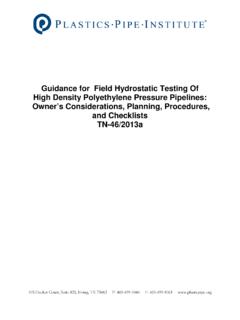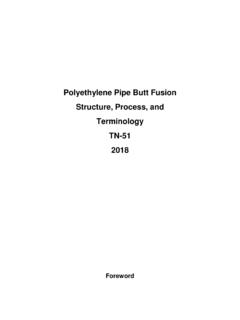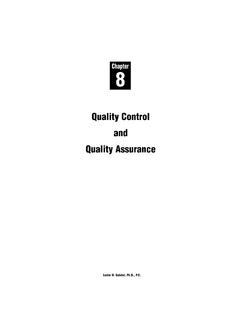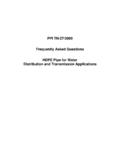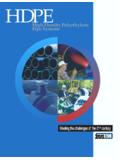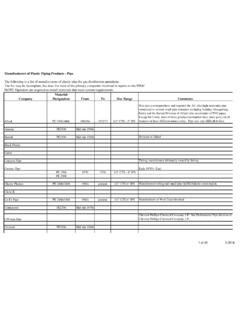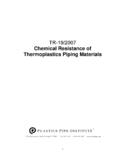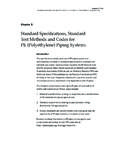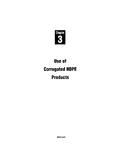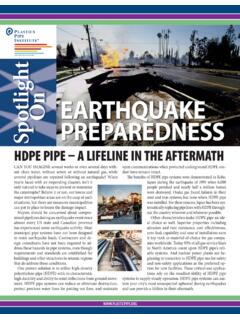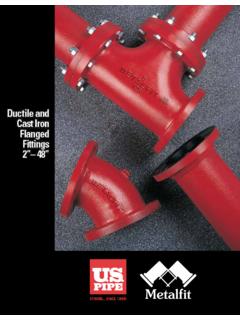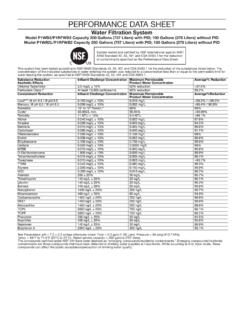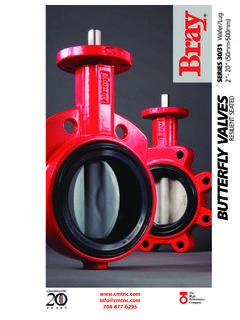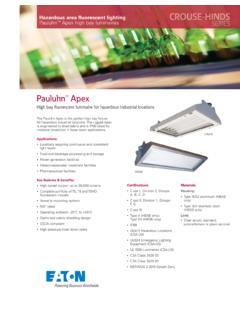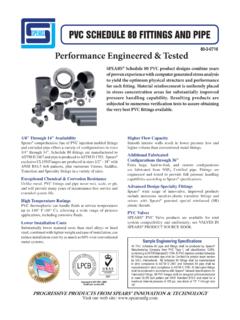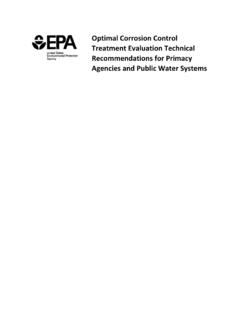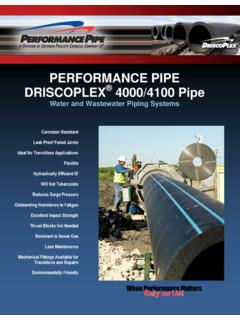Transcription of TR-3/2016 HDB/HDS/PDB/ SDB/MRS/CRS Policies …
1 TR-3/ 2016 HDB/HDS/PDB/ SDB/MRS/CRS Policies Policies and procedures for developing hydrostatic Design Basis (HDB), hydrostatic Design Stresses (HDS), Pressure Design Basis (PDB), Strength Design Basis (SDB), Minimum Required Strength (MRS) Ratings, and Categorized Required Strength (CRS) for Thermoplastic Piping Materials or Pipe 105 Decker Court, Suite 825, Irving, TX 75062 Phone: 469-499-1044 Fax: 469-499-1063 TABLE OF CONTENTS Foreword Notes to the Reader Acronyms and Definitions Summary of Changes Part A - Grades of Recommendations and Data requirements for HDB and PDB Grades of Recommendation Requirements for Grades at 73oF (23oC) Requirements for Grades at 140oF (60oC) Requirements for Grades at 180oF (82oC)
2 Requirements for Grades at 200oF (93oC) Recommended HDB for New Materials Recommended PDB Ratings for Multilayer and Composite Pipes Pressure Rating of Thermoplastic Pipes with Barrier Layers Substitution of Ingredients in Polyolefin/Aluminum/Polyolefin Composite Pipe Constructions Recommended HDB and PDB Rating Using ASTM D2992 Part B - Grades of Recommendations and Data Requirements for MRS and CRS ,t Grades of Recommendation Protocol for Determination of MRS and CRS.
3 T Part C - Grades of Recommendations and Data Requirements for SDB Grades of Recommendation Changes to Formulations Guidance to Use of SDB Part D - General Policies , Practices, and procedures Policy on Colorant Changes for HDB Policy for Determining Long-Term Strength (LTHS) by Temperature Interpolation Policy on Dependent Listings Changes Between Two Percentages of a Compounding Ingredient Measurement Variability Requirements for Molding Materials Establishing the hydrostatic Design Stress for a Material 2 Part E - PVC Specific Policies .
4 Practices and procedures Standard Industry Practice of High Intensity Mixing of PVC Pipe Compounds Policy on Substitution of an Apparently Identical Ingredient in a PVC Composition Fulfilling Certain PPI TR-3 Requirements by Utilizing an Alternate Method of Analyzing Stress-Rupture Data for PVC Substitution of Resin in Poly (vinyl chloride) PVC Plastic Pipe Formulations Allowable Formulation Variability for PVC Pipe and Fittings Compositions Substitution of Thermal Stabilizers in PVC Pipe Compositions Part F - Polyethylene Specific Policies , Practices and procedures Substitution of Thermal Stabilizers in PE Plastics Pipe Compounds Variation in Amount of Stabilizer in PE Plastics Pipe Compounds Substitution of Ultraviolet Light Stabilizers in Non-Black PE Plastics Pipe Compounds Determination and Validation of the hydrostatic Design Basis (HDB)
5 For Polyethylene Piping Materials hydrostatic Design Basis Substantiation for PE Materials Policy on Establishing Equivalence of Modified PE Pipe Compositions Requirements for Polyethylene (PE) Materials to Qualify for a Higher Design Factor Part G - PEX Specific Policies , Practices and procedures Protocol for PPI Listing of PEX Pipe in PPI TR-4 Policy on Formulation Modifications for PEX HDB Listings Policy on Establishing Equivalence of Modified PEX Pipe Compositions Part H - Chlorinated Poly (Vinyl Chloride) (CPVC) Specific Policies , Practices and procedures Policy for Obtaining a hydrostatic Design Basis (HDB) for a new CPVC Compound Policy on Substitution of an Apparently Identical Ingredient in a CPVC Composition Fulfilling Certain PPI TR-3 Requirements by Utilizing an Alternate Method of Analyzing Stress-Rupture Data for CPVC Substitution of Resin in Chlorinated Poly (Vinyl Chloride) (CPVC)
6 Plastic Pipe Formulations 3 Allowable Formulation Variability for CPVC Pipe and Fittings Compounds Substitution of Thermal Stabilizers in CPVC Pipe Compositions Appendices Test Data Report Requirements Checklist for HSB Submissions Additional Information Release of Recommendations Appeals of hydrostatic Stress Board Actions Confidentiality Suggested Letters for Transmitting the Information Required by Various Parts of this Report Letters from Owner of Independent Listing (For Part ) Letter from Intended Receiver of Independent Listing (For Part ) For Part : Resin Substitution in PVC Compositions For TR-2/TR-4: PVC Generic Range Formulation Calculation Example to Convert PVC Compound Formulations from PHR to Weight Percent Plastics Pipe Institute Membership 4 FOREWORD TR-3/ 2016 HDB/HDS/PDB/ SDB/MRS/CRS Policies This report presents the Policies and procedures used by the HSB ( hydrostatic Stress Board) of PPI (Plastics Pipe Institute, Inc.)
7 To develop recommendations of long-term strength ratings for commercial thermoplastic piping materials or pipe. Recommendations are published in PPI TR-4, "PPI Listing of hydrostatic Design Basis (HDB), Pressure Design Basis (PDB), Strength Design Basis (SDB) and Minimum Required Strength MRS) Ratings for Thermoplastic Piping Materials or Pipe", a regularly updated document. PPI is a trade association dedicated to promoting the effective use of plastics piping systems. Since the early 1960s, HSB has worked as a volunteer group under PPI's auspices to issue listings and continually evaluate and update procedures for long-term strength forecasting.
8 Listings are developed from stress rupture data submitted to the HSB by the manufacturer. The general method used to evaluate the data is given in ASTM D2837, "Standard Test Method for Obtaining hydrostatic Design Basis for Thermoplastic Pipe Materials," for HDB, SDB and PDB listings, or in ISO 9080 for MRS listings, with additional requirements delineated in this report. Many important national and international thermoplastic piping standards, including those issued by ASTM, ISO (International Standards Organization), NSF International, AWWA (American Water Works Association), ANSI (American National Standards Institute), ASME (American Society of Mechanical Engineers) and the API (American Petroleum Institute), reference these HSB/PPI listed long-term strength recommended ratings.
9 This report was prepared by PPI as a service to the industry. The information in this report is offered in good faith and believed to be accurate at the time of its preparation, but is offered as is without any express or implied warranty, including WARRANTIES OF MERCHANTABILITY AND FITNESS FOR A PARTICULAR PURPOSE. Additional information may be needed in some areas, especially with regard to unusual or special applications. Consult the manufacturer or material supplier for more detailed information. PPI does not endorse the proprietary products or processes of any manufacturer, and assumes no responsibility for compliance with applicable laws and regulations.
10 Questions, comments, and problems of interpretation should be referred to the Chairman of the HSB, Plastics Pipe Institute, 105 Decker Court, Suite 825, Irving, TX 75062. Copies of this report, as well as other publications, are available from the PPI website: This report was updated March 2016 . 5 NOTES TO THE READER SOME RULES AND CONDITIONS Techniques: It is stressed that these Policies and procedures are for developmentof recommended ratings for thermoplastics piping compounds or pipe based on test data fromgood quality pipes (extruded or molded) made by specific processing techniques. Theserecommended ratings may or may not be valid for products made by differing and Acronyms: Definitions and Acronyms are shown in the next section.
